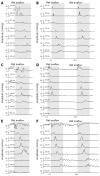Habitual rapid food intake and ineffective esophageal motility
- PMID: 23599655
- PMCID: PMC3627893
- DOI: 10.3748/wjg.v19.i14.2270
Habitual rapid food intake and ineffective esophageal motility
Abstract
Aim: To study non-cardiac chest pain (NCCP) in relation to ineffective esophageal motility (IEM) and rapid food intake.
Methods: NCCP patients with a self-reported habit of fast eating underwent esophageal manometry for the diagnosis of IEM. Telephone interviews identified eating habits of additional IEM patients. Comparison of manometric features was done among IEM patients with and without the habit of rapid food intake and healthy controls. A case study investigated the effect of 6-mo gum chewing on restoration of esophageal motility in an IEM patient. The Valsalva maneuver was performed in IEM patients and healthy controls to assess the compliance of the esophagus in response to abdominal pressure increase.
Results: Although most patients diagnosed with NCCP do not exhibit IEM, remarkably, all 12 NCCP patients who were self-reporting fast eaters with a main complaint of chest pain (75.0%) had contraction amplitudes in the mid and distal esophagus that were significantly lower compared with healthy controls [(23.45 mmHg (95%CI: 14.06-32.85) vs 58.80 mmHg (95%CI: 42.56-75.04), P < 0.01 and 28.29 mmHg (95%CI: 21.77-34.81) vs 50.75 mmHg (95%CI: 38.44-63.05), P < 0.01, respectively)]. In 7 normal-eating IEM patients with a main complaint of sensation of obstruction (42.9%), the mid amplitude was smaller than in the controls [30.09 mmHg (95%CI: 19.48-40.70) vs 58.80 mmHg (95%CI: 42.56-75.04), P < 0.05]. There was no statistically significant difference in manometric features between the fast-eating and normal-eating groups. One NCCP patient who self-reported fast eating and was subsequently diagnosed with IEM did not improve with proton-pump inhibition but restored swallow-induced contractions upon 6-mo gum-chewing. The Valsalva maneuver caused a markedly reduced pressure rise in the mid and proximal esophagus in the IEM patients.
Conclusion: Habitual rapid food intake may lead to IEM. A prospective study is needed to validate this hypothesis. Gum-chewing might strengthen weakened esophageal muscles.
Keywords: Esophageal manometry; Ineffective esophageal motility; Non-cardiac chest pain; Rapid food intake; Valsalva maneuver.
Figures




Similar articles
-
Factors predictive of gastroesophageal reflux disease and esophageal motility disorders in patients with non-cardiac chest pain.Scand J Gastroenterol. 2018 Jun;53(6):643-649. doi: 10.1080/00365521.2018.1452975. Epub 2018 May 30. Scand J Gastroenterol. 2018. PMID: 29848163
-
Ineffective esophageal motility (IEM): the primary finding in patients with nonspecific esophageal motility disorder.Dig Dis Sci. 1997 Sep;42(9):1859-65. doi: 10.1023/a:1018802908358. Dig Dis Sci. 1997. PMID: 9331148
-
Revised criterion for diagnosis of ineffective esophageal motility is associated with more frequent dysphagia and greater bolus transit abnormalities.Am J Gastroenterol. 2008 Mar;103(3):699-704. doi: 10.1111/j.1572-0241.2007.01593.x. Am J Gastroenterol. 2008. PMID: 18341490
-
Ineffective Esophageal Motility (IEM): the Old-New Frontier in Esophagology.Curr Gastroenterol Rep. 2016 Jan;18(1):1. doi: 10.1007/s11894-015-0472-y. Curr Gastroenterol Rep. 2016. PMID: 26685862 Review.
-
Noncardiac chest pain: diagnosis and management.Curr Opin Gastroenterol. 2017 Jul;33(4):293-300. doi: 10.1097/MOG.0000000000000374. Curr Opin Gastroenterol. 2017. PMID: 28463855 Review.
Cited by
-
Manometric Subtypes of Ineffective Esophageal Motility.Clin Transl Gastroenterol. 2017 Mar 9;8(3):e78. doi: 10.1038/ctg.2017.4. Clin Transl Gastroenterol. 2017. PMID: 28277491 Free PMC article.
-
Ineffective esophageal motility and the vagus: current challenges and future prospects.Clin Exp Gastroenterol. 2016 Sep 20;9:291-299. doi: 10.2147/CEG.S111820. eCollection 2016. Clin Exp Gastroenterol. 2016. PMID: 27703389 Free PMC article. Review.
References
-
- Fass R, Dickman R. Non-cardiac chest pain: an update. Neurogastroenterol Motil. 2006;18:408–417. - PubMed
-
- Cheung TK, Lim PW, Wong BC. The view of gastroenterologists on non-cardiac chest pain in Asia. Aliment Pharmacol Ther. 2007;26:597–603. - PubMed
-
- Hsieh SD, Muto T, Murase T, Tsuji H, Arase Y. Eating until feeling full and rapid eating both increase metabolic risk factors in Japanese men and women. Public Health Nutr. 2011;14:1266–1269. - PubMed
Publication types
MeSH terms
Substances
LinkOut - more resources
Full Text Sources
Other Literature Sources
Medical

